DROSERA
With sunlight they are wonderful to observe due to the shimmers on their droplets or because of the green leaves in contrast to the red hairs. I tried to grow up few kinds of droseras :
- Drosera adelae (lanced-leafed sundew)is a tropical one and its cultivation is specific as most of the Australian carnivorous plants.
- Drosera admirabilis (= D.cuneifolia) is a rosetted drosera coming from South-Africa.
- Drosera aliciae (Alice sundew) near the same as D.capensis to make it grow but less bulky. It's a rosetted drosera.
- Drosera binata (fork-leafed sundew) is a kind of carnivorous grass with two branches. My first one has only two ramifications, it's the most common. But some have four like dichotoma variety or more like multifida variety I am now growing too.
- Drosera burmanni is a small ephemeral carnivorous plant which likes tropical environment.
- Drosera capensis (Cape sundew) the rookie's carnivorous plant. This is easiest to find and to grow up.
- Drosera capillaris is the american D.rotundifolia with a little bit different shape.
- Drosera filiformis ssp. tracyi is the tallest sub-specie of this kind. It has long tentacle that can reach 20 inches.
- Drosera prolifera like D.adelae it comes from Queensland and hates much sunshines.
- Drosera sp. 'Floating' as its name says it is floating when water level go up and uses its root like an anchor.
- Drosera spatulata (spoon leaf sundew) accepts temperate and tropical wheater conditions. Mine is the "Okinawa rose" variety.
- Drosera X beleziana (D.rotundifolia X D.intermedia) is an hybrid looking like D.intermedia but rather thin.
- Drosera X intermedia (D.rotundifolia X D.anglica) is a european one which doesn't like to be in the shadow of other plants.
- Drosera X obovata (D.anglica X D.rotundifolia X ...) is thiner and smaller than D.capensis though they have same looking. As it name says its leaves are oval.
Drosera adelae :
| Temp. (°C / °F) | Light | Climate | Origin | Remarks | |
| min. | max. | Shade | Tropical | Australia (Queensland) | Keep wet all year round |
| 18 / 65 | 35 / 95 | ||||

 It's apart from the others above due to its origin, Queensland (Australia). It's apart from most of droseras because of its specific natural growing conditions (tropical). So it can't bare too low or high temperatures and no more dry hair. At least 70 % of relative humidity is necessary, only possible in a greenhouse in temperate climate. To keep mine in good conditions I use a large pot on which I put steel trusses with plastic (to conserve food) over it. In these condition it has grown well and flowered too. Unfortunately, during my holidays, cold has killed it and now only small shoots left. It's not a plant to live in a flat! But it will do well in a terrarium with high humidity level and no sunlight. Flowers are very small but nice like a red star but I didn't have much seeds. After I found the right care it grows fast and many shoots are produced from emerging roots. From them it can quickly overgrow your terrarium. When they get old they seem to be stronger and can bare harder cold in winter and barely shaded sun light.
It's apart from the others above due to its origin, Queensland (Australia). It's apart from most of droseras because of its specific natural growing conditions (tropical). So it can't bare too low or high temperatures and no more dry hair. At least 70 % of relative humidity is necessary, only possible in a greenhouse in temperate climate. To keep mine in good conditions I use a large pot on which I put steel trusses with plastic (to conserve food) over it. In these condition it has grown well and flowered too. Unfortunately, during my holidays, cold has killed it and now only small shoots left. It's not a plant to live in a flat! But it will do well in a terrarium with high humidity level and no sunlight. Flowers are very small but nice like a red star but I didn't have much seeds. After I found the right care it grows fast and many shoots are produced from emerging roots. From them it can quickly overgrow your terrarium. When they get old they seem to be stronger and can bare harder cold in winter and barely shaded sun light.
Drosera admirabilis :
| Temp. (°C / °F) | Light | Climate | Origin | Remarks | |
| min. | max. | Half-shade, full sun | Warm temperate, subtropical | South Africa | Short winter dormancy |
| 8 / 46 | 35 / 95 | ||||
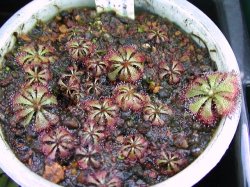 It's not the easiest one. I grow it from seeds which is not very fast. In summer, it doesn't like too much heat but in full sun it will produce very nice red rosettes. My troubles come from the night temperature that are too warm. I have lost some because of this but I have one in a terrarium that does'nt make any trouble. In cooler conditions it grows easily and is very nice with its compact rosette. I'm now waiting for its flower.
It's not the easiest one. I grow it from seeds which is not very fast. In summer, it doesn't like too much heat but in full sun it will produce very nice red rosettes. My troubles come from the night temperature that are too warm. I have lost some because of this but I have one in a terrarium that does'nt make any trouble. In cooler conditions it grows easily and is very nice with its compact rosette. I'm now waiting for its flower.
Drosera aliciae :
| Temp. (°C / °F) | Light | Climate | Origin | Remarks | |
| min. | max. | Half-shade, full sun | Warm temperate, subtropical | South Africa | Short winter dormancy |
| 8 / 46 | 35 / 95 | ||||
 It's no more difficult than drosera capensis. The mayor difference is the appearance, a kind of rosette stack that makes it less bulky and easier to put it on shelves. Its less abundant flowering makes it less attractive. I don't know if it's due to cultivation conditions(the same for both) or if it's always like this for this plant. Perhaps artificial light is not sufficient because it flowers only in sun light or something else? It will need few seasons before I got a more precise idea. About the prey catch it's slower than drosera capensis and impossible to see. It needs few days and you can only see changes of positions day by day. Its usual preys are gnats, mosquitoes and other small flying insects and sometimes some walking ones due to its leaves curving down to the ground.
It's no more difficult than drosera capensis. The mayor difference is the appearance, a kind of rosette stack that makes it less bulky and easier to put it on shelves. Its less abundant flowering makes it less attractive. I don't know if it's due to cultivation conditions(the same for both) or if it's always like this for this plant. Perhaps artificial light is not sufficient because it flowers only in sun light or something else? It will need few seasons before I got a more precise idea. About the prey catch it's slower than drosera capensis and impossible to see. It needs few days and you can only see changes of positions day by day. Its usual preys are gnats, mosquitoes and other small flying insects and sometimes some walking ones due to its leaves curving down to the ground.
It's a plant that seems to me less interesting than drosera capensis but takes some advantages to it. Its rosettes don't overflow the pot that is great for small cultivation. Because it's staying near the ground it could be useful in a home peat bog or a terrarium as a green cover. Greenflies are dangerous for it too, it doesn't like hard cold and dry conditions as many droseras.
Drosera binata :
| Temp. (°C / °F) | Light | Climate | Origin | Remarks | |
| min. | max. | Full sun | Temperate | Australia, New Zealand | Winter dormancy |
| < 2 / < 36 | 35 / 95 | ||||
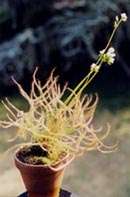 Near the same as D.capensis about cultivation but grows slower and flowers less. Pollination is not so easy and seeds are less numerous. On the other way my specie seems to be "aphid resistant". It grows more vertically that could be interesting if you have not so much place for it. There are different varieties. The typical one has two branches. As the leaf has unrolled it's like a fork more or less opened from a "T" to a sharp "Y". The other varieties are : 'multifida' that divides four times and has thicker leaves and 'dichotoma'that makes lots of ramifications. Hairs are long enough, about 0.2 inches, that allows it to catch
some big preys. It's more resistant to cold than D.capensis. During winter it takes an hibernation shape with no more leaves to grow again better at spring. There is no particular problem to consider with this plant.
Near the same as D.capensis about cultivation but grows slower and flowers less. Pollination is not so easy and seeds are less numerous. On the other way my specie seems to be "aphid resistant". It grows more vertically that could be interesting if you have not so much place for it. There are different varieties. The typical one has two branches. As the leaf has unrolled it's like a fork more or less opened from a "T" to a sharp "Y". The other varieties are : 'multifida' that divides four times and has thicker leaves and 'dichotoma'that makes lots of ramifications. Hairs are long enough, about 0.2 inches, that allows it to catch
some big preys. It's more resistant to cold than D.capensis. During winter it takes an hibernation shape with no more leaves to grow again better at spring. There is no particular problem to consider with this plant.
Drosera burmanni :
| Temp. (°C / °F) | Light | Climate | Origin | Remarks | |
| min. | max. | Full sun | Tropical | N. to E. Australia, Asia | Annual |
| 18 / 65 | 35 / 95 | ||||
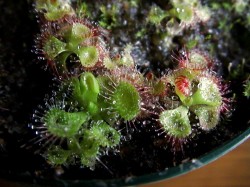 Wonderful small plant that grows quick enough from seeds. It'd better do because it's an annual plant. It's easy to grow but old leaves could rot easily if it's too wet and warm. Leaf move is fast and very accentuated. I didn't yet obtain flowers and succeded in keeping it during the second year only in a terrarium. I don't understand it yet very well.
Wonderful small plant that grows quick enough from seeds. It'd better do because it's an annual plant. It's easy to grow but old leaves could rot easily if it's too wet and warm. Leaf move is fast and very accentuated. I didn't yet obtain flowers and succeded in keeping it during the second year only in a terrarium. I don't understand it yet very well.
Drosera capensis :
| Temp. (°C / °F) | Light | Climate | Origin | Remarks | |
| min. | max. | Full sun | Warm temperate, subtropical | South Africa | Keep wet all year round |
| 8 / 46 | 35 / 95 | ||||
 Especially interesting because easy to grow and reproduce and has a nice looking. Hairs on the leaves become red if the light is provided in sufficient quantity. I put them outside in the direct sun as soon as temperature allowed it. They take deep red colours and have many flowers. In fact, on one flower spike, flowers open one by each day with noon sun. They close during the night and so on. If some insect have this way or your brush seeds are made in huge quantities. The pots of the other plants have even been invaded by these seeds because of the wind that have thrown them over. They really grow easily so that they quickly overflow their pots!
Especially interesting because easy to grow and reproduce and has a nice looking. Hairs on the leaves become red if the light is provided in sufficient quantity. I put them outside in the direct sun as soon as temperature allowed it. They take deep red colours and have many flowers. In fact, on one flower spike, flowers open one by each day with noon sun. They close during the night and so on. If some insect have this way or your brush seeds are made in huge quantities. The pots of the other plants have even been invaded by these seeds because of the wind that have thrown them over. They really grow easily so that they quickly overflow their pots!
If you want the droplets of "glue" to be abundant and so have an efficient trap, you have to give much light and enough humidity in the air and in the ground. If the air relative humidity is below 40 to 50 % (it depends on temperature too) much part of the droplets evaporates. Good values seem to be above 65 or 70 %. In good conditions this plant catch easily some insects(flying ones) about the size of a small fly but not wasps or bees. Leaves move quiet slowly, impossible to see but with a huge catch the leaf can make several turns around it! When you see the position has changed at each observation you really feel it's alive unlike with "common" plants. I had only one difficulty with this plant it was greenflies. Many times they came back though I used an insecticide spray. It was not very good, young leaves were burned and the whole plant stopped growing up for a while but it's over. In fact this was due to the gas (butane). Now I only use powder of systemic insecticide I mix with water.
Drosera capillaris :
| Temp. (°C / °F) | Light | Climate | Origin | Remarks | |
| min. | max. | Full sun | Warm to cold temperate | America | Sometime annual |
| 8 / 46 | 35 / 95 | ||||
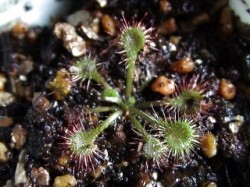 One more rosetted drosera! It is a little bit more difficult than the others like aliciae. It doesn't like hot weather and excess or lack of humidity.
One more rosetted drosera! It is a little bit more difficult than the others like aliciae. It doesn't like hot weather and excess or lack of humidity.
Drosera filiformis ssp. tracyi :
| Temp. (°C / °F) | Light | Climate | Origin | Remarks | |
| min. | max. | Full sun | Warm temperate | USA (S.E.) | Winter dormancy |
| 8 / 46 | 35 / 95 | ||||
 This subspecie of D.filiformis grows easily from seeds but it does slowly and is very sensitive to fungus and rot. Don't keep it too damp and not to dry too it doesn't like it more. When you find the right way it's not very difficult to grow it. In winter it is reduced to a tiny bud. There is a tropical type that doesn't go dormant in winter.
This subspecie of D.filiformis grows easily from seeds but it does slowly and is very sensitive to fungus and rot. Don't keep it too damp and not to dry too it doesn't like it more. When you find the right way it's not very difficult to grow it. In winter it is reduced to a tiny bud. There is a tropical type that doesn't go dormant in winter.
Drosera prolifera :
| Temp. (°C / °F) | Light | Climate | Origin | Remarks | |
| min. | max. | Shade | Tropical | Australia (Queensland) | warm and humid all year round |
| 18 / 65 | 35 / 95 | ||||
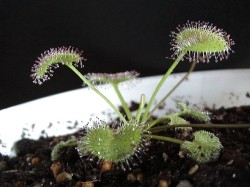 One of the sisters of D.adelae but it really can't bear sunshine. Only shaded and wet condition will be convenient. Sunshine would lead to death more or less faster. It reproduces easily and in a unique way for carnivorous plants: New shoots grows from the end of the flowers stalk when it reaches the ground. High humidity level and a warm and constant temperature are the key to the success.
One of the sisters of D.adelae but it really can't bear sunshine. Only shaded and wet condition will be convenient. Sunshine would lead to death more or less faster. It reproduces easily and in a unique way for carnivorous plants: New shoots grows from the end of the flowers stalk when it reaches the ground. High humidity level and a warm and constant temperature are the key to the success.
Drosera sp. 'Floating' :
| Temp. (°C / °F) | Light | Climate | Origin | Remarks | |
| min. | max. | Full sun | Warm temperate | South Africa | Overflowed at spring |
| 8 / 46 | 35 / 95 | ||||
 Very interesting rosetted plant. I grow it from seeds. It needs damp condition at spring and sometime even overflowed but in summer don't keep it too damp or it will rot. Mucilage on the hairy leaves is really abundant.
Very interesting rosetted plant. I grow it from seeds. It needs damp condition at spring and sometime even overflowed but in summer don't keep it too damp or it will rot. Mucilage on the hairy leaves is really abundant.
Drosera spatulata :
| Temp. (°C / °F) | Light | Climate | Origin | Remarks | |
| min. | max. | Full sun | Warm temperate, subtropical, tropical | Asia, south Japan to north Australia | Slow down in winter |
| 10 / 50 | 35 / 95 | ||||
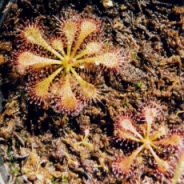 I've planted seeds during winter but only few have grown up. It grows slowly but the plant is well shaped after few weeks even if it stays small. It looks like D.aliciae in shape and size but its leaves become pink to red and not those of its cousin. Growing speed is very different from one plant to another. As some reach 1 inch of diameter others are only 0.2 inches! Flowers from this variety are pale pink with white center. They just stay opened few hours in full sun and sometime only few minutes if there is not enough sun. To get more seeds you'd better use a brush to pollinate it. Then you will just have to wait till the seeds' bag open.
I've planted seeds during winter but only few have grown up. It grows slowly but the plant is well shaped after few weeks even if it stays small. It looks like D.aliciae in shape and size but its leaves become pink to red and not those of its cousin. Growing speed is very different from one plant to another. As some reach 1 inch of diameter others are only 0.2 inches! Flowers from this variety are pale pink with white center. They just stay opened few hours in full sun and sometime only few minutes if there is not enough sun. To get more seeds you'd better use a brush to pollinate it. Then you will just have to wait till the seeds' bag open.
Drosera X beleziana :
| Temp. (°C / °F) | Light | Climate | Origin | Remarks | |
| min. | max. | Full sun | Temperate | Europa | Winter dormancy |
| 5 / 41 | 35 / 95 | ||||
 D.rotundifolia X D.intermedia looks like D.intermedia. I found it in the pot of my sarracenias. In winter it goes dormant and forms a small rosette. All leaves from the year die but new ones are made at spring and in the meantime it reproduces by stolons. If you let it have its dormancy it won't be difficult to grow it. In summer it produces numerous small white flowers only visible early in the morning. I've got many seeds too but this hybrid should be sterile so I'm not yet so sure of its identity. It could be as well a D.intermedia's form or D.X beleziana crossed with D.intermedia.
D.rotundifolia X D.intermedia looks like D.intermedia. I found it in the pot of my sarracenias. In winter it goes dormant and forms a small rosette. All leaves from the year die but new ones are made at spring and in the meantime it reproduces by stolons. If you let it have its dormancy it won't be difficult to grow it. In summer it produces numerous small white flowers only visible early in the morning. I've got many seeds too but this hybrid should be sterile so I'm not yet so sure of its identity. It could be as well a D.intermedia's form or D.X beleziana crossed with D.intermedia.
Drosera X intermedia :
| Temp. (°C / °F) | Light | Climate | Origin | Remarks | |
| min. | max. | Full sun | Temperate | Cultivation hybrid | Winter dormancy |
| 5 / 41 | 35 / 95 | ||||
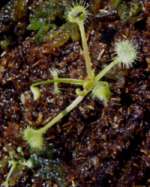 When I bought D.rotundifolia X D.anglica it was a small shoot, in fact three small shoots that I have quickly seperated. Roots are very small (perhaps this plant come from a bigger one), but it seems to be vigorous. The shape of leaves is rather like D.rotundifolia. Every week a new leaf is growing and the biggest plant has already got a flower stick. Take care, flowers use a lot of energy and so the plant grows really slower when there are some flowers. After at least three weeks you can take seeds. As food it can catch gnats easily. It reproduces itself with its leaves that stay on the ground (in June with 80% of air humidity and 82°F). A new plant grows from there!
When I bought D.rotundifolia X D.anglica it was a small shoot, in fact three small shoots that I have quickly seperated. Roots are very small (perhaps this plant come from a bigger one), but it seems to be vigorous. The shape of leaves is rather like D.rotundifolia. Every week a new leaf is growing and the biggest plant has already got a flower stick. Take care, flowers use a lot of energy and so the plant grows really slower when there are some flowers. After at least three weeks you can take seeds. As food it can catch gnats easily. It reproduces itself with its leaves that stay on the ground (in June with 80% of air humidity and 82°F). A new plant grows from there!
Drosera X obovata :
| Temp. (°C / °F) | Light | Climate | Origin | Remarks | |
| min. | max. | Full sun | Temperate | Europa | Keep wet all year round |
| 5 / 41 | 35 / 95 | ||||
 This one I found in Okinawa. Unfortunately there were some aphids too. Now I've thrown away these nasty animals it grows well enough. Its shape is near the same as D.anglica and it is rather smaller than D.capensis that should allow me to put it in my terrarium. Flowers are abundants, 4 flower sticks in few weeks. After one week or two there are a lot of seeds. Here there is something wrong it's a sterile hybrid! After few researches the best answer (given by Peter D'Amato) seems to be that it has been backcrossed with D.anglica. In fact it could be (D.anglica X D.rotundifolia) X D.anglica, but nothing is less sure... It reproduces itself too by the end of its leaves that stay on the ground and make a new plant from there. So to reproduce it is really easy. It doesn't seem to be any particular difficulty.
This one I found in Okinawa. Unfortunately there were some aphids too. Now I've thrown away these nasty animals it grows well enough. Its shape is near the same as D.anglica and it is rather smaller than D.capensis that should allow me to put it in my terrarium. Flowers are abundants, 4 flower sticks in few weeks. After one week or two there are a lot of seeds. Here there is something wrong it's a sterile hybrid! After few researches the best answer (given by Peter D'Amato) seems to be that it has been backcrossed with D.anglica. In fact it could be (D.anglica X D.rotundifolia) X D.anglica, but nothing is less sure... It reproduces itself too by the end of its leaves that stay on the ground and make a new plant from there. So to reproduce it is really easy. It doesn't seem to be any particular difficulty.
Last modification on Saturday 08/02/2008
URL: http://gelinaud.free.fr/carni/pagdyn.php